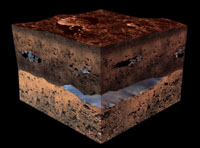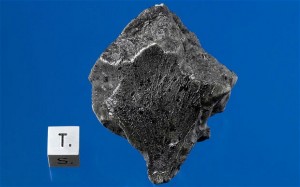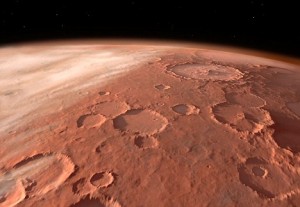April 29, 2014 – If you are a regular reader of this blog then you know I have a fascination with the planet Mars. We have learned a considerable amount about the planet’s origins through the orbiters and rovers we have sent there. In addition we have studied meteorites of Martian origin, like the one found in Morocco and seen in the image below, to reconstitute the planet’s past history.
Skeptics among you are asking “how do we know a meteorite originated from Mars?” We know because we can match the gases trapped in the meteorites with the composition of the Martian atmosphere. You see some of those gases get trapped in small pockets within meteorites and that makes it easy for us to do a match. And how do meteorites get from Mars to Earth? By being blasted off the surface of the planet by impacts from other meteorites striking Mars. We can see evidence of those impacts in the many craters pocking the surface of the planet.
Getting back to the reason for this posting, it appears that Japanese researchers at the Tokyo Institute of Technology have been able to map the water history of Mars from 4.5 billion years ago to the present and the results appear in a paper published in March in the journal Astrophysics. What they have discovered is that more than 50% of the total water inventory of Mars vanished in its first 400 million years of existence.
They know this by studying the historical changes in ratios of deuterium and hydrogen isotopes found in those meteorites determined to be of Martian origin. Hydrogen is lighter than deuterium and therefore is much more likely to escape from a planet’s atmosphere. Deuterium being heavier tends to be retained. We know today on Mars that the deuterium to hydrogen ratio is six times greater than that found on Earth. And in studying the Martian meteorites we have collected that range from 1 billion to 4.5 billion years in age we can measure the changing ratios to determine the rate of water loss over the life of the planet. Two meteorites, one 4.5 billion years old and another at 4.1 billion tell the woeful tale of significant water loss over 400 million years. After that the meteorite record shows a far more gradual decline.
The Martian rovers and orbiters reveal a picture of Mars that once upon a time was populated by shallow seas, lakes and rivers. We see the evidence in the surface geography. But now we know that this wet Mars period was confined to very early in the planet’s history. Since then surface water has vanished. But the ratios show there is still water on Mars and more than the amount we can calculate from studying the two polar ice caps, a mixture of water and dry ice (frozen carbon dioxide).
So where is it? Mars has water and it is likely to be found in underground sediments and pockets. And much of it is probably locked up in the equivalent to our permafrost in subsurface soils from the sub-polar regions to the mid-latitudes. In their conclusions the authors of the paper state, “we propose a possibility that there should be undetected subsurface water/ice of much greater extent than the collective amounts of the visible current water inventory.”
That’s good news for humans planning to establish a future habitation on Mars. At some point those hidden assets will prove to be life savers providing fuel (hydrogen), air (oxygen) and water to the colonists. The search for those hidden reservoirs will become an important quest for future explorers both robotic and human.
(Artist illustration of hidden water on Mars courtesy of Medialab, ESA 2001. See link at http://www.cnes.fr/web/CNES-en/1483-revealing-the-red-planets-secrets.php )














